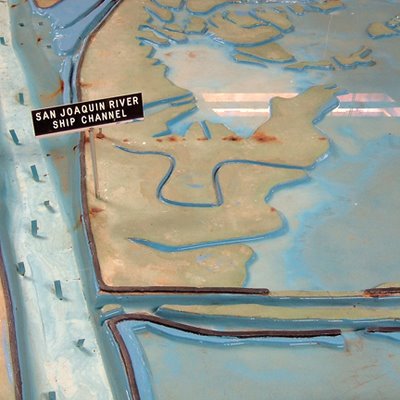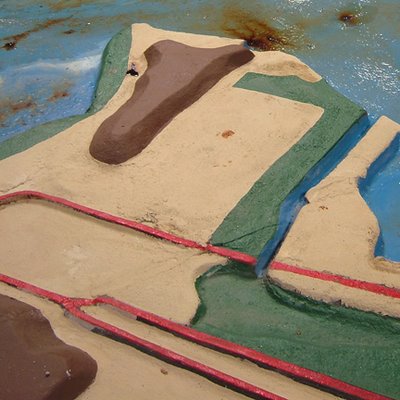One of the most memorable scenes in Roberto Saviano’s book Gomorrah is his description of the illegal waste-dumping schemes of southern Italy’s Camorra organized crime syndicate. In a chapter called “Land of Fires,” Saviano conjures a Blakean landscape of rampant groundwater toxins, dispersed radioactivity, industrial sludges, paints, and slowly lethal atmospheres perfumed with hexavalent chromium. Unsurprisingly, a new report shows that cancer rates in the region have spiked, including “‘excessive’ instances of tumors, especially brain tumors.”
Tag: William Blake
San Francisco Bay Hydrological Model
In Sausalito, CA, near a 7-11, one finds the San Francisco Bay Hydrological Model.

The Bay Model was built in 1957 by the Army Corps of Engineers; it is “over 1.5 acres in size and represents an area from the Pacific Ocean to Sacramento and Stockton, including: the San Francisco, San Pablo and Suisun Bays and a portion of the Sacramento-San Joaquin Delta.” Which means it’s larger than two American football fields. (I think).

The Model served “as a scientific research tool from 1958-2000 to evaluate circulation and flow characteristics of the water within the estuary system,” allowing Army Engineers “to simulate currents, tidal action, sediment movement and the mixing of fresh and salt water. Pollution, salt-water intrusion, barrier and fill studies were a few of the important research projects that have been undertaken at the Bay Model.”
It’s not in the greatest condition, and the faded primary color scheme leaves something to be desired, but the model is no less fascinating for that; any chance you get to walk the shores of a microcosm is a good chance to do some thinking.

If I may briefly quote William Blake –
To see a world in a grain of sand
And a heaven in a wild flower
Hold infinity in the palm of your hand
And eternity in an hour
– I’ll then point out that the Bay Model exists within its own timezone: in the world of the Model, one day passes every 14.9 minutes. 30 full days elapse every 7.2 hours. Complete tidal cycles run 3.8 minutes. You can practically feel yourself aging in the presence of this copyscape, its wetlands and alluvial braids of artificial rivers running through fields of pumps and power cords.
Look closely and you’ll see a “Tide Hut” where little gods of the Model enact catastrophe and unleash floods upon the surrogate world spread out before them. Look closer, and you’ll see damage from a “hundred years of waves, subsidence, and boat wakes” – which, in Model time, is almost exactly one human year.

But I soon got to thinking about the politics of architectural models. Imagine what would happen, for instance, if some Navy SEALS raided a cave in Afghanistan and found the Bay Model sitting there: what on earth does al-Qaeda want with San Francisco’s water supply? FOX News screams. Or a model of Greater London’s Thames hydrology, complete with flood gates, Barriers and overflow sewers, which is one thing if it’s in the possession of Tony Blair, and quite another if found in the basement of, say, Abu Hamza or even Timothy McVeigh.
What were they trying to do with it?
It’s the politics of architectural models: an object of scientific curiosity in one person’s hands is an issue of national security in another’s.
Or: simulacra as a threat to national security.
A plot for a new Philip K. Dick novel, or a film by Charlie Kauffman, then came to mind: a man, perhaps a young Al Pacino, breaks into the Bay Model in the middle of the night. He barricades himself inside, turns on the power, and starts flooding the model, demolishing bridges, rerouting estuarial confluences. He jumps up and down, causing modelquakes, and then accelerates the tides, obliterating Golden Gate Park under the force of a single wave.
He calls all the local newspapers and takes responsibility for the disasters now befalling San Francisco outside; but what disasters? they ask, and he thinks they’re conning him, denying his rage, because he’s read William Blake and St. Thomas Aquinas and he believes that everything he throws at that simulacrum there before him will have effects in the real world…
Because it’s all building up to one moment, see, the big moment when he decides to flood the Bay Model’s model of the Bay Model, opening up a rift in the universe and blasting him head-first through the macrocosm.
Until the police break-in…
(Thanks to Chad for the tip, and to Nicola for coming with me!)
Sound dunes
“Sand dunes in certain parts of the world are notorious for the noises they make,” New Scientist reports, “as sand avalanches down their sides. Some [dunes] emit low powerful booms, others sound like drum rolls or galloping horses, and some are even tuneful. These dune songs have been reported to last for up to 15 minutes and can sound as loud as a low-flying airplane.”
To test for the causes, properties, and other effects of these sand dune booms, “Stéphane Douady of the French national research agency CNRS and his colleagues shipped sand from Moroccan singing dunes back to his lab to investigate.” There, Douady’s team “found that they could play notes by pushing the sand by hand, or with a metal handle.”

The transformation of a sand dune – and, by extension, the entire Sahara desert, indeed any desert – even, by extension, the rust deserts of Mars – into a musical instrument. Music of the spheres, indeed.
“When the sand avalanches, the grains jostle each other at different frequencies, setting up standing waves in the cascading layer, says Douady. These waves reinforce one another, making the layer vibrate like the surface of a loud speaker. ‘What’s funny is that in these massive dunes, only a thin layer of 2 or 3 centimetres is needed to set up the resonance,’ says Douady. ‘Soon all grains begin to vibrate in step.'”
Douady has so perfected his technique of dune resonance that he has now “successfully predicted the notes emitted by dunes in Morocco, Chile and the US simply by measuring the size of the grains they contain.” The music of the dunes, in other words, was determined entirely by the size, shape, and roughness of the sand grains involved, where excessive smoothness dampened the dunes’ sound.

I’m reminded of the coast of Inishowen, a peninsula south of Malin Head in the north of Ireland, where the rocks endlessly grind across one another in the backwash of heaving, metallic, grey Atlantic waves. Under constant pressure of the oceanic, the rocks carve into themselves and each other, chipping down over decades into perfectly polished and rounded spheres, columns, and eggs – as if Archimedean solids or the nested orbits of Kepler could be discovered on the Irish ocean foreshore –

– all glittering. The rocks, I later learned, were actually semi-precious stones, and I had a kind of weird epiphany, standing there above the hush and clatter of bejewelled rocks, rubbing and rubbed one to the other in the depopulated void of a coastal November. It was not a sound easy to forget.
Because the earth itself is already a musical instrument: there is “a deep, low-frequency rumble that is present in the ground even when there are no earthquakes happening. Dubbed the ‘Earth’s hum‘, the signal had gone unnoticed in previous studies because it looked like noise in the data.”
Elsewhere: “Competing with the natural emissions from stars and other celestial objects, our Earth sings like a canary – it drones on in a constant hum of a gazillion notes. If it were several octaves higher, and hence, audible to the human ear,” it could probably get recorded by the unpredictably omnidirectional antennas of ShortWaveMusic and… you could download the sound of the earth. Free Radio Interterrestrial. [Note: the “drones on” link, a sentence or two back, offers a contrary theory (published in 2000) about the origins of these planetary sound waves.]
Which, finally, brings us to Ernst Chladni and his Chladni figures, or: architectonic structures appearing in sand due to patterns of acoustic resonance. The architecture of sand, involving sound—or architecture through sound, involving sand. Silicon assuming structure, humming.
The gist of Chladni’s experiments involved spreading a thin layer of sand across a vibrating plate, changing the frequency at which the plate vibrated, and then watching the sand as it shivered round, forming regular, highly geometric patterns. Those patterns depended upon, and were formed in response to, whatever vibration frequency it was that Chladni chose.




So you’ve got sand, dune music, terrestrial vibration, some Chladni figures – one could be excused for wondering whether the earth, apparently a kind of carbon-ironic bell made of continental plates and oceanic resonators, is really a vast Chladni plate, vibrating every little mineral, every pebble, every grain of sand, perhaps every organic molecule, into complex, three-dimensional, time-persistent patterns for which we have no standard or even technique of measurement. Or maybe William Blake knew how to do it, or Pythagoras, or perhaps even Nikola Tesla, but…
The sound dunes continue to boom and shiver. The deserts roar. The continents hum.